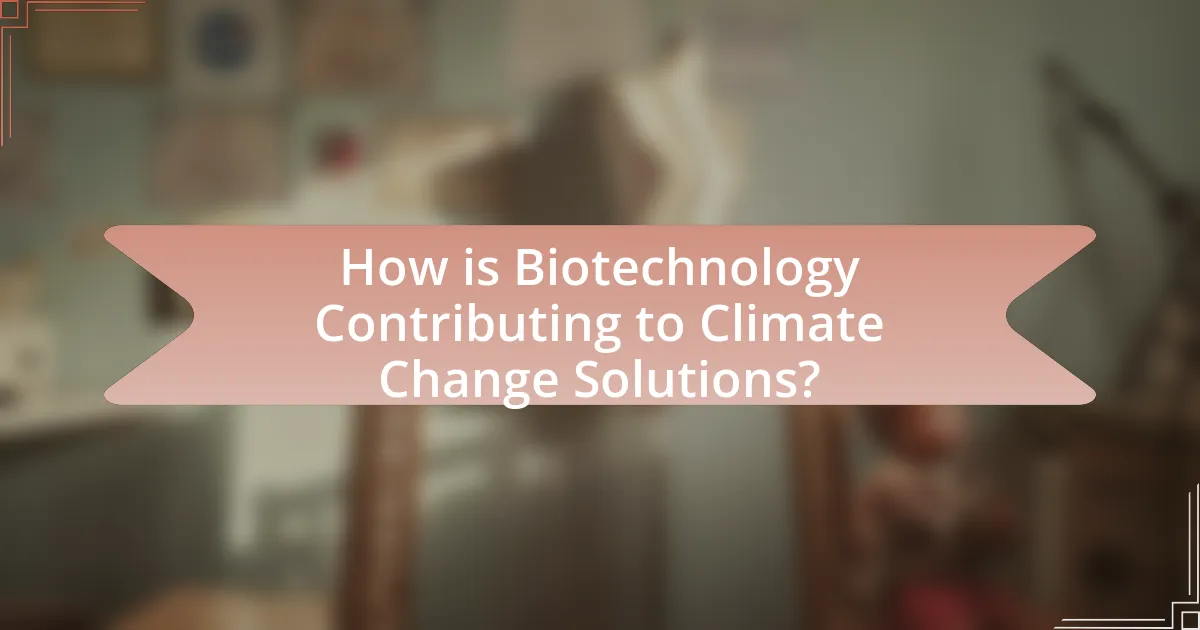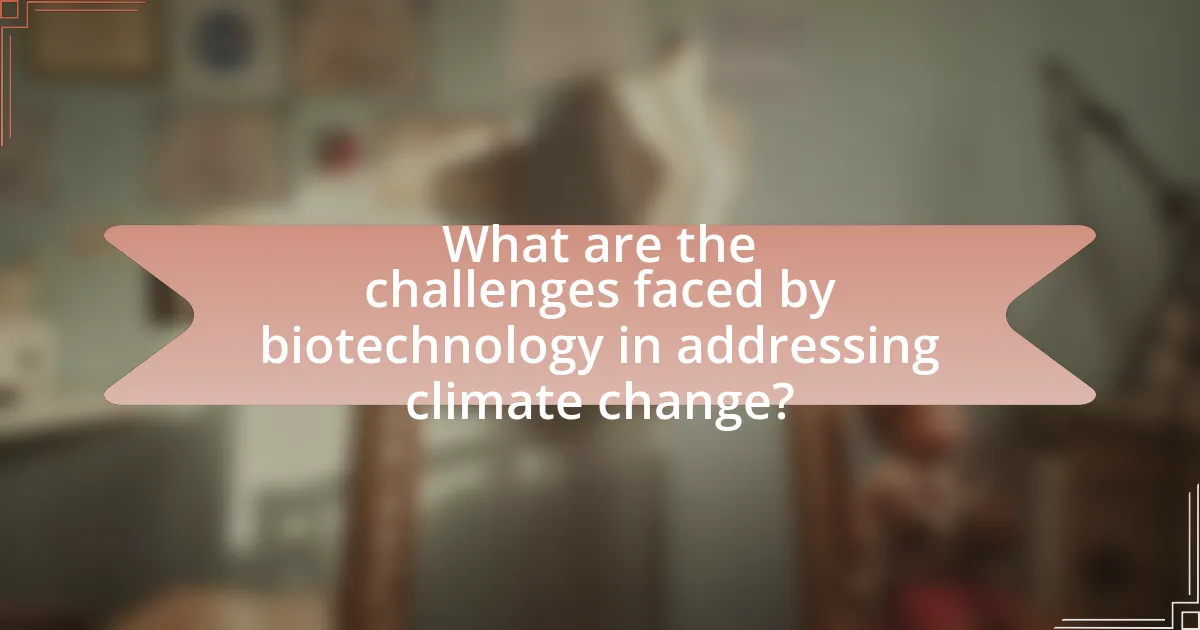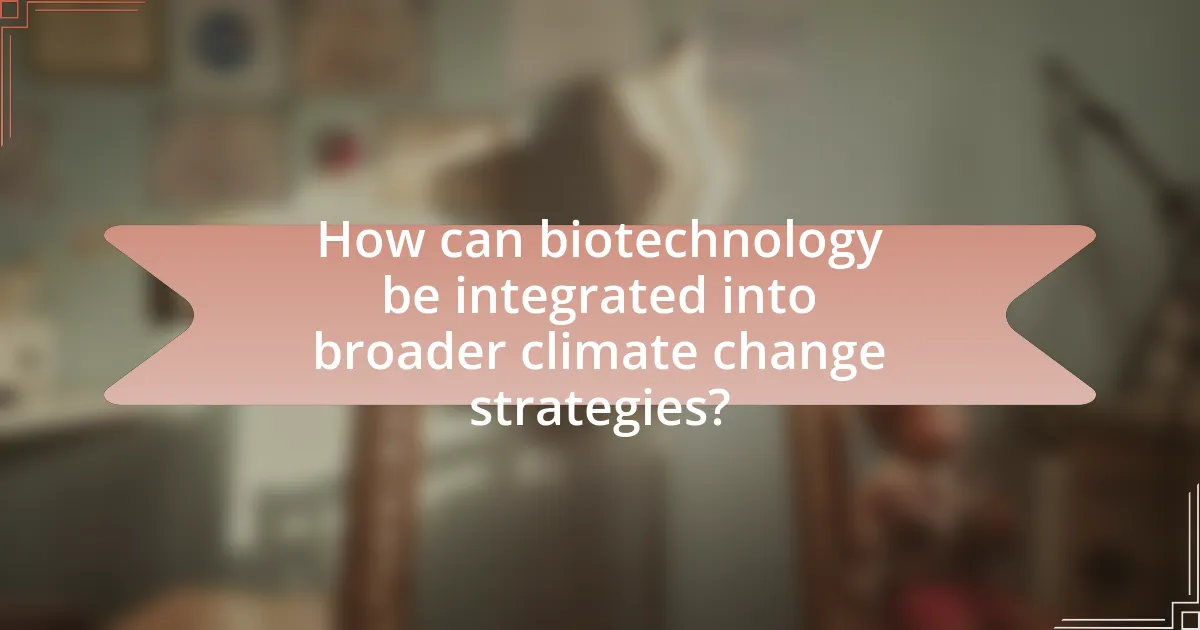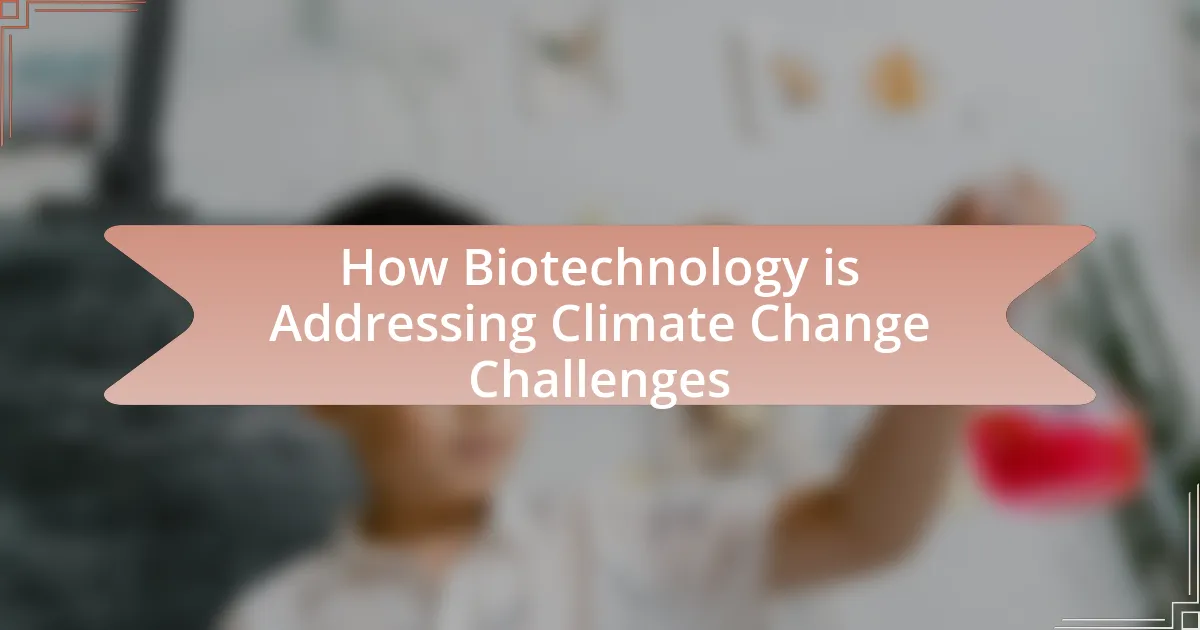Biotechnology is increasingly recognized as a vital tool in addressing climate change challenges through sustainable agricultural practices, biofuels, and carbon capture technologies. The article explores various biotechnological approaches, including genetic engineering, bioremediation, and the use of microbial systems, which enhance crop resilience, reduce greenhouse gas emissions, and improve ecosystem health. It also discusses the significance of regulatory frameworks, public perception, and ethical considerations in the adoption of biotechnological innovations. Furthermore, the article highlights the collaborative efforts necessary for effective implementation and the key factors for measuring the success of biotechnology in mitigating climate change impacts.

How is Biotechnology Contributing to Climate Change Solutions?
Biotechnology is contributing to climate change solutions by developing sustainable agricultural practices and biofuels that reduce greenhouse gas emissions. For instance, genetically modified crops can enhance yield and resilience to climate stressors, thereby minimizing the need for chemical fertilizers and pesticides, which are significant sources of emissions. Additionally, biofuels produced from biomass can replace fossil fuels, leading to a reduction in carbon dioxide emissions. According to a study published in “Nature Climate Change,” biofuels can reduce greenhouse gas emissions by up to 80% compared to traditional fossil fuels. This evidence underscores the role of biotechnology in creating innovative solutions that mitigate climate change impacts.
What are the key biotechnological approaches to combat climate change?
Key biotechnological approaches to combat climate change include genetic engineering, bioremediation, and bioenergy production. Genetic engineering enhances crop resilience to climate stressors, improving yields and reducing the need for chemical inputs; for instance, drought-resistant varieties can significantly increase food security in arid regions. Bioremediation utilizes microorganisms to detoxify polluted environments, effectively restoring ecosystems affected by climate change. Bioenergy production, particularly through the use of algae and biomass, provides renewable energy sources that can reduce greenhouse gas emissions; research indicates that algae can produce up to 30 times more oil per acre than traditional crops. These approaches collectively contribute to mitigating the impacts of climate change while promoting sustainable practices.
How does genetic engineering play a role in climate resilience?
Genetic engineering enhances climate resilience by developing crops that can withstand extreme weather conditions, such as drought, flooding, and temperature fluctuations. For instance, genetically modified organisms (GMOs) like drought-resistant maize have been engineered to maintain yield under water-scarce conditions, which is crucial as climate change increases the frequency of droughts. Research published in the journal “Nature” demonstrates that these crops can reduce the risk of crop failure, thereby ensuring food security in changing climates. Additionally, genetic engineering can improve plant traits such as nutrient use efficiency and pest resistance, further contributing to agricultural sustainability in the face of climate challenges.
What is the significance of microbial biotechnology in carbon capture?
Microbial biotechnology plays a crucial role in carbon capture by utilizing microorganisms to convert carbon dioxide into useful products, thereby reducing greenhouse gas emissions. This process leverages the natural metabolic pathways of microbes, such as bacteria and algae, which can efficiently fix carbon dioxide through photosynthesis or chemosynthesis. For instance, certain cyanobacteria can capture carbon dioxide and produce biomass, which can be further processed into biofuels or bioplastics, effectively sequestering carbon in the process. Research has shown that microbial systems can achieve significant carbon capture rates, with studies indicating that engineered microbes can sequester up to 90% of carbon dioxide in specific environments. This demonstrates the potential of microbial biotechnology as a sustainable solution to mitigate climate change impacts.
Why is biotechnology considered a vital tool in sustainable agriculture?
Biotechnology is considered a vital tool in sustainable agriculture because it enhances crop resilience, increases yield, and reduces the need for chemical inputs. By utilizing genetic modification and other biotechnological methods, crops can be engineered to withstand environmental stresses such as drought, pests, and diseases, which are increasingly prevalent due to climate change. For instance, genetically modified crops like Bt cotton and Bt corn have shown significant reductions in pesticide use, leading to lower environmental impact and improved farmer profitability. Additionally, biotechnology can contribute to more efficient nutrient use, as seen in biofortified crops that provide essential vitamins and minerals, addressing both agricultural productivity and nutritional deficiencies.
How do biopesticides and biofertilizers reduce environmental impact?
Biopesticides and biofertilizers reduce environmental impact by minimizing chemical inputs and enhancing soil health. Biopesticides, derived from natural organisms, target specific pests without harming beneficial insects or the ecosystem, thus reducing chemical pesticide usage that can lead to soil and water contamination. Biofertilizers, which contain living microorganisms, improve nutrient availability and soil structure, promoting sustainable agricultural practices. Research indicates that the use of biopesticides can decrease chemical pesticide application by up to 50%, while biofertilizers can enhance crop yields by improving nutrient uptake, leading to less reliance on synthetic fertilizers. This shift not only lowers the risk of pollution but also supports biodiversity and soil fertility, contributing to a more sustainable agricultural system.
What role do genetically modified organisms (GMOs) play in reducing greenhouse gas emissions?
Genetically modified organisms (GMOs) play a significant role in reducing greenhouse gas emissions by enhancing agricultural efficiency and reducing the need for chemical inputs. For instance, GMOs can be engineered to be more resistant to pests and diseases, which decreases the reliance on chemical pesticides and fertilizers that contribute to emissions during their production and application. Research indicates that the adoption of GM crops has led to a reduction of approximately 23 billion kilograms of carbon dioxide emissions annually, equivalent to taking 10 million cars off the road. Additionally, GMOs can improve crop yields on existing farmland, thereby minimizing the need to convert natural ecosystems into agricultural land, which further helps in preserving carbon sinks.

What are the challenges faced by biotechnology in addressing climate change?
Biotechnology faces several challenges in addressing climate change, including regulatory hurdles, public acceptance, and technological limitations. Regulatory frameworks often lag behind advancements in biotechnology, creating uncertainty for developers and investors. Public acceptance is critical, as skepticism about genetically modified organisms can hinder the adoption of biotechnological solutions. Additionally, technological limitations, such as the need for scalable production methods and the complexity of ecosystems, pose significant barriers to effectively implementing biotechnological innovations for climate change mitigation. These challenges must be navigated to harness biotechnology’s full potential in combating climate change.
How do regulatory frameworks impact biotechnological innovations?
Regulatory frameworks significantly influence biotechnological innovations by establishing guidelines that govern research, development, and commercialization processes. These frameworks can either facilitate or hinder innovation; for instance, stringent regulations may slow down the approval of new biotechnological products, while supportive policies can accelerate their development and deployment. A study by the National Academies of Sciences, Engineering, and Medicine in 2017 highlighted that clear regulatory pathways can enhance public trust and encourage investment in biotechnological research aimed at addressing climate change. Thus, the nature of regulatory frameworks directly affects the pace and direction of biotechnological advancements in climate solutions.
What are the ethical considerations surrounding biotechnological solutions?
The ethical considerations surrounding biotechnological solutions include concerns about safety, environmental impact, equity, and consent. Safety issues arise from potential risks associated with genetically modified organisms (GMOs), which may affect biodiversity and ecosystem stability. Environmental impact considerations focus on the long-term effects of biotechnological interventions on natural habitats and species. Equity concerns address the accessibility of biotechnological advancements, ensuring that benefits are distributed fairly among different populations, particularly marginalized communities. Consent is crucial in biotechnological applications, especially in human genetic modifications, where informed consent must be obtained from individuals involved. These considerations are essential to ensure responsible development and application of biotechnological solutions in addressing climate change challenges.
How can public perception influence the adoption of biotechnology?
Public perception significantly influences the adoption of biotechnology by shaping societal acceptance and regulatory frameworks. When the public views biotechnology positively, it can lead to increased investment, supportive policies, and faster implementation of biotechnological solutions, particularly in addressing climate change. For instance, a survey by the Pew Research Center in 2021 indicated that 65% of Americans support the use of genetically modified organisms (GMOs) in agriculture, which can enhance crop resilience to climate-related stresses. Conversely, negative perceptions, often fueled by misinformation or ethical concerns, can result in public resistance, leading to stricter regulations and slower adoption rates. This dynamic illustrates that public sentiment directly impacts the pace and extent to which biotechnological innovations are integrated into climate change strategies.
What are the limitations of current biotechnological methods?
Current biotechnological methods face several limitations, including high costs, regulatory hurdles, and ethical concerns. High costs hinder widespread adoption, as developing and implementing biotechnological solutions can require significant financial investment. Regulatory hurdles often slow down the approval process for new biotechnological products, limiting their availability in the market. Ethical concerns, particularly regarding genetic modification and its implications, can lead to public resistance and affect policy decisions. These limitations collectively impact the effectiveness and scalability of biotechnological approaches in addressing climate change challenges.
How do economic factors affect the implementation of biotechnological solutions?
Economic factors significantly influence the implementation of biotechnological solutions by determining funding availability, market demand, and regulatory environments. For instance, high initial investment costs can limit the development of biotechnological innovations, as seen in the agricultural sector where companies often require substantial capital to develop genetically modified crops. Additionally, market demand for sustainable products can drive investment in biotechnological solutions; a report by the International Service for the Acquisition of Agri-biotech Applications indicated that the global market for biotech crops reached $19.8 billion in 2020, reflecting consumer interest in sustainable agriculture. Furthermore, supportive regulatory frameworks can facilitate or hinder the adoption of biotechnological solutions, as evidenced by the varying approval processes across countries, which can impact the speed and extent of implementation.
What are the potential risks associated with biotechnological interventions?
Biotechnological interventions pose several potential risks, including ecological disruption, unintended consequences on biodiversity, and health concerns related to genetically modified organisms (GMOs). Ecological disruption can occur when engineered organisms outcompete native species, leading to imbalances in ecosystems. For instance, the introduction of genetically modified crops may affect local flora and fauna, as seen in studies where Bt corn impacted non-target insect populations. Additionally, unintended consequences may arise from gene transfer between modified and wild species, potentially creating hybrid organisms with unpredictable traits. Health concerns include allergic reactions or long-term health effects from consuming GMOs, as highlighted by ongoing debates and research on the safety of genetically modified foods. These risks necessitate careful assessment and regulation to mitigate potential negative impacts on the environment and human health.

How can biotechnology be integrated into broader climate change strategies?
Biotechnology can be integrated into broader climate change strategies by developing sustainable agricultural practices, enhancing carbon capture technologies, and creating biofuels from renewable resources. For instance, genetically modified crops can increase yield and resilience to climate stressors, reducing the need for chemical fertilizers and pesticides, which contribute to greenhouse gas emissions. Additionally, biotechnological advancements in microbial processes can improve carbon sequestration in soil, as demonstrated by research from the University of California, which found that specific soil microbes can enhance carbon storage by up to 30%. Furthermore, biofuels produced through biotechnological methods can replace fossil fuels, significantly lowering carbon emissions; the U.S. Department of Energy reports that biofuels can reduce greenhouse gas emissions by 50-90% compared to traditional gasoline. These applications illustrate how biotechnology plays a crucial role in mitigating climate change impacts.
What collaborative efforts are necessary for effective biotechnological applications?
Effective biotechnological applications require collaborative efforts among researchers, industry stakeholders, and policymakers. These collaborations facilitate the sharing of knowledge, resources, and technologies essential for innovation. For instance, partnerships between academic institutions and biotech companies can accelerate the development of sustainable agricultural practices, as evidenced by projects like the International Rice Research Institute’s collaboration with private firms to enhance rice varieties that withstand climate stressors. Additionally, regulatory frameworks established through cooperation between governments and scientific communities ensure that biotechnological advancements are safe and effective, promoting public trust and adoption.
How can partnerships between governments and biotech companies enhance climate action?
Partnerships between governments and biotech companies can enhance climate action by facilitating the development and deployment of innovative biotechnological solutions aimed at reducing greenhouse gas emissions and promoting sustainable practices. For instance, governments can provide funding and regulatory support, while biotech companies can leverage their expertise in genetic engineering and synthetic biology to create biofuels, carbon capture technologies, and climate-resilient crops. A notable example is the collaboration between the U.S. Department of Energy and biotech firms to advance bioenergy technologies, which has led to significant reductions in carbon emissions. This synergy not only accelerates research and development but also ensures that effective climate solutions are implemented at scale, thereby addressing climate change challenges more effectively.
What role do research institutions play in advancing biotechnological solutions?
Research institutions play a critical role in advancing biotechnological solutions by conducting innovative research, developing new technologies, and facilitating collaboration among scientists, industry, and policymakers. These institutions generate foundational knowledge that drives the development of biotechnological applications, such as genetically modified organisms for improved crop resilience against climate change. For instance, the International Rice Research Institute has developed flood-resistant rice varieties, demonstrating how research institutions can directly contribute to food security in changing climates. Additionally, they often secure funding and resources to support large-scale projects, enabling the translation of laboratory findings into practical solutions that address environmental challenges.
What best practices can be adopted for successful biotechnological interventions?
Successful biotechnological interventions can be achieved by adopting best practices such as thorough research and development, stakeholder engagement, and regulatory compliance. Thorough research and development ensure that biotechnological solutions are scientifically sound and effective; for instance, the development of drought-resistant crops through genetic modification has been validated by numerous studies demonstrating increased yield under water-scarce conditions. Stakeholder engagement, including collaboration with local communities and industries, fosters acceptance and enhances the applicability of biotechnological solutions, as seen in projects like the African Orphan Crops Consortium, which involves local farmers in crop improvement efforts. Regulatory compliance is crucial to ensure safety and efficacy, as evidenced by the rigorous approval processes for genetically modified organisms in various countries, which help maintain public trust and environmental safety.
How can stakeholders ensure the sustainability of biotechnological solutions?
Stakeholders can ensure the sustainability of biotechnological solutions by implementing rigorous regulatory frameworks and promoting collaborative research initiatives. Regulatory frameworks, such as the Cartagena Protocol on Biosafety, provide guidelines for the safe use of biotechnology, ensuring that environmental and health risks are assessed and managed effectively. Collaborative research initiatives, like the Global Alliance for Climate-Smart Agriculture, foster partnerships among governments, academia, and industry, facilitating the sharing of knowledge and resources to develop sustainable biotechnological practices. These approaches are essential for aligning biotechnological advancements with environmental sustainability goals, ultimately contributing to climate change mitigation efforts.
What are the key factors for measuring the success of biotechnology in climate change mitigation?
The key factors for measuring the success of biotechnology in climate change mitigation include greenhouse gas reduction, carbon sequestration efficiency, and the enhancement of ecosystem resilience. Greenhouse gas reduction is quantified by the decrease in emissions attributed to biotechnological innovations, such as biofuels and genetically modified organisms that require fewer inputs. Carbon sequestration efficiency is assessed by the ability of biotechnological solutions, like biochar and engineered plants, to capture and store carbon dioxide effectively in soils and biomass. Ecosystem resilience is evaluated through the capacity of biotechnological interventions to restore and maintain biodiversity, which is crucial for adapting to climate impacts. These factors provide a comprehensive framework for assessing the effectiveness of biotechnological approaches in combating climate change.


